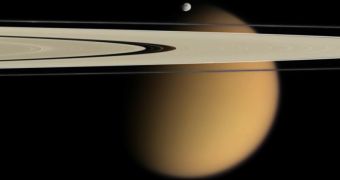New observations with the Cassini orbiter show that Saturn's moon Titan contains large quantities of hydrocarbon liquid, about a few hundred times more than the natural reserves found here on Earth. Hydrocarbon gas condenses into Titan's dense atmosphere, then it is raining down on its surface much in the same way water rain falls on our planet, and the liquid is collected in vast deposits to form lakes and dunes of natural gas.
Titan has a surface temperature of about -179 degrees Celsius and contains a great deal of hydrocarbons in the form of methane and ethane, and probably some tholins, a complex mix of organic materials that are thought to have been the origin of prebiotic chemistry that lead to the apparition and evolution of life on our planet. Ralph Lorentz of the Cassini radar team and the author of the study writes that Titan is most likely covered with carbon-rich materials, fact that may reveal some of the moon's climate history and geology.
So far, the Cassini orbiter was only capable of mapping about 20 percent of the total surface area of Titan, observing, in the process, several hundred of hydrocarbon filled lakes which could contain a volume of natural gas at least ten times greater than that on Earth, plus a series of other organic materials forming dark dunes around Titan's equator, a hundred times more than our coal reserves.
It is generally believed that, at this moment, on Earth exist at least 130 thousands million tons of natural gas, roughly enough to power the whole U.S. for the next 300 years; this quantity represents only the proven reserves of natural gas. However, a natural gas lake on the surface on Titan could alone contain enough natural gas to provide with this amount of energy, Lorentz says.
And remember, this is only on 20 percent of the surface area of Titan. Who knows what the rest of the unexplored territory may reserve? The general area probed by Cassini lies near the northern polar regions, thus it is easy to correlate that the same phenomenons may occur in the southern regions of the moon. Nonetheless, while probing the southern pole, Cassini was only able to spot two such lakes, very small in comparison with those observed in the northern regions.
Planetary scientists estimate on the base of the average depth of lakes on Earth and observing the surrounding terrain that some of the methane lakes are sometimes less than 10 meters deep, making it impossible for Cassini's radar to detect them.
Like on Earth, natural gas in general and methane in particular are strong greenhouse effect gases, thus the most important question is now how much methane is actually trapped into a liquid form on the surface of Titan, as, if all liquid was to be methane, then it could only last for a few million years before escaping into the moons atmosphere, breaking down, after which it could escape into space, making Titan a much colder place than it already is.
However, many million years passed since Titan came to existence, thus scientists argue that its climate might have varied violently in the past, and the methane reserves could have been provided through a cryovolcanic process, from the interior of the moon towards its surface.
Titan is also a good example for the complex environment required for the appearance and evolution of life. We are carbon-based life forms, and there are a lot of carbon-rich materials on the surface of Titan. It is expected that Cassini's mapping of Saturn's moon to be resumed during the scheduled fly-by on 22 February, when it will also monitor the general area where the Huygens probe landed three years ago after being dropped from the Cassini orbiter.

 14 DAY TRIAL //
14 DAY TRIAL // 
